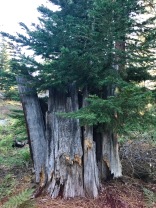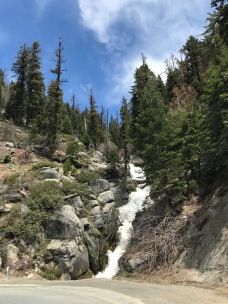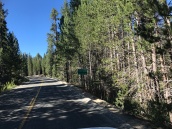History of Ponderosa
Situated near the summit of the Upper Tule River of the Sequoia National Forest, Bordering on the eastern side of the Great Western divide Highway, lines one of the most beautiful, well planned, mountain home subdivisions in the high Sierras. The area is well studded with all varieties of fir and pine trees, especially the Ponderosa pine, for which the subdivision was named; interspersed are groves of Quaking Aspen. The subdivision is part of the Kramer meadow property that has been owned by three generations of the Kramer family for a hundred years.
Alexander S. Kramer, born and raised in Pennsylvania, came to California in 1874. He filed for a homestead site about two and a half mils south of Alila, (now Earlimart). He engaged in sheep raising about 1878. His brother, Howard, came to California later and joined him as a partner. Their operation grew to be very large, numbering ten thousand heard of sheep, which fed on open range between Delano and Earlimart. The area was very good feed for most of the year, but the brothers decided they needed summer pasture for their sheep. They found several thousand acres in and around what is now know as the Johnsondale area, which was the private property of George Flitz. At that time, there were no roads beyond Springville. All food and supplies for the sheep herders, including salt for the sheep, had to be packed in on animals, so there was a need for a pasture for the horses and pack animals.
In the NE¼ of the NE½ of Section 16, Township 21 South, Range 32, the Kramers found forty acres which were ideal for their pasture needs. This land, which had been granted to the state for schools was patented to the Kramers on May 25, 1884. It became known as Kramer Meadow and still retains that name.
The Kramer brothers dissolved their partnership in 1903, and afterward, Alex bought two hundred eighty acres in the same Section 16, which was patented on March 18, 1904. The present Ponderosa subdivision is part of this acreage.
The area around Kramer Meadow is fairly level and is known as bench land. It was a camping area for Indian tribes who come to the high mountains to get out of the hot valley for the summer, and by tribes migrating between the Owens and San Joaquin Valleys. Many mortar holes used by the Indians for grinding grain and acorns are still visible west of Kramer Creek, east of the old cabin site, and in other areas near Kramer Meadow. The ample pasture and adequate water made it ideal as a stopping place for trappers and explorers crossing the Sierras between San Joaquin and Owens Valleys as early as 1851.
The Flitz property, where Kramers pastured their sheep for may years, was traded to the National Forest Service and the Kramers were issued a permit for grazing in Upper Little Kern basin, between Little Kern east to the Big Kern to the south of what is now the Sequoia National Park. Kramers brought their sheep up to the mountains through the Indian Reservation east of Porterville, leaving there about May 1st., then on to higher range, coming in on the south side of Slate Mountain and following a designated trail laid out by the Forest Service, arriving at Kramer Meadow about July 1st., and using the meadow as a stop over for the bands of sheep before into the Little Kern area.
Alex Kramer discontinued bringing his sheep to the mountains in 1925 due to two factors: the Sequoia National Park area was closed to sheep grazing, and the drought of the 1920’s reduced the desirability of the pasture land.
In 1932, Harvey Slade, of Delano, leased the meadow area of Kramer Meadow for his trotting horses and young colts. He fenced the area and built the first cabin on the property, which stood on the hill east of Kramer Creek. After the death of Slade, his wife gave the cabin to Mr. Henry Muller of Terra Bella. It was then moved further east near a good spring on National Forest Service property. Mr Muller and his family used the cabin, and pastured their horses on the meadow until Mr. Muller’s death. The cabin was again moved back to the west of its present site just west of Kramer Creek, overlooking the meadow.
Alex S. Kramer died July, 1936, and his three sons, Alexander J., Clarence A., of Bakersfield, and Herbert H., of Earlimart, inherited the property.
In 1940, John Bateman, of Tulare, leased a portion of Kramer Meadow and established a saw mill. He logged the area west of Kramer Creek and as far north as what is now Snowflake Drive. The saw mill site was just east of Kramer Drive and south of the present Langston cabin. He built two large cabins, one for his family and the other a kitchen and dining room for his help. He also built five small cabins to house the help. The kitchen cabin was later destroyed by heavy snow, but the five smaller cabins remained for many years. Early residents of Ponderosa remember these very well. These small cabins were later removed to other areas or torn down. The family cabin was eventually remodeled and is being used by the Herbert Kramer family.
Mr. Bateman also established a water system, developing a spring that lies just west of the present Muller cabin, and piping water to his mill and cabins using a gasoline engine for pumping. After closing the mill, he removed the equipment and water system.
About the same time that Mr. Bateman had the saw mill, a partnership consisting of Harris, McHart, and Bowden, leased ten acres on the north end of the property, in the area where Fox Drive is now. They raised silver foxes for safe of fur. They built a cabin and some animal runs for the foxes. The project was short lived, being abandoned when the U.S. entered World War II and gas rationing made it difficult to obtain the proper food for the foxes. The cabin and runs later collapsed due to heavy snow.
In 1951, Lyman Lumber Company of Springville did some selective logging on the west side of Kramer Meadow and to the north boundary, taking out many mature trees and transporting the logs to a mill in Springville.
After the death of Clarence Kramer, his widow, Ona, sold her interest in Kramer Meadow to Don Carter, a real estate developer from Santa Barbara. This entailed dividing the property into three portions. At the time of the division of the property, A. J. Kramer sold his interest in Kramer Meadow to Herbert and Anna Kramer, retaining five acres that borders the Great Western Divide Highway south of the Ponderosa Lodge. Don Carter started subdividing his portion and the Ponderosa was born. The first subdivision tract map #391 was recorded May 1, 1963.
(NOTE: This above history was compiled and written by Anna Kramer, July 1984)



















